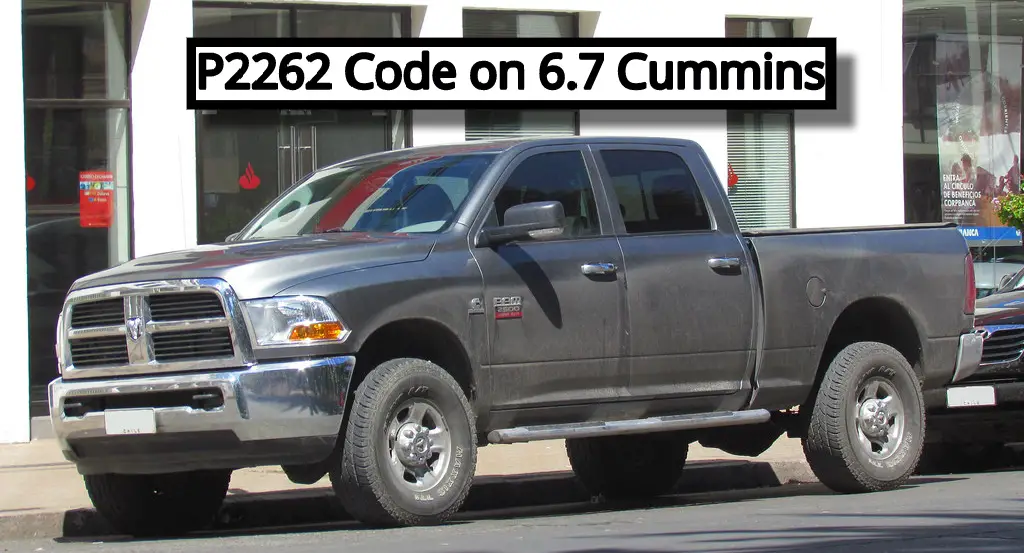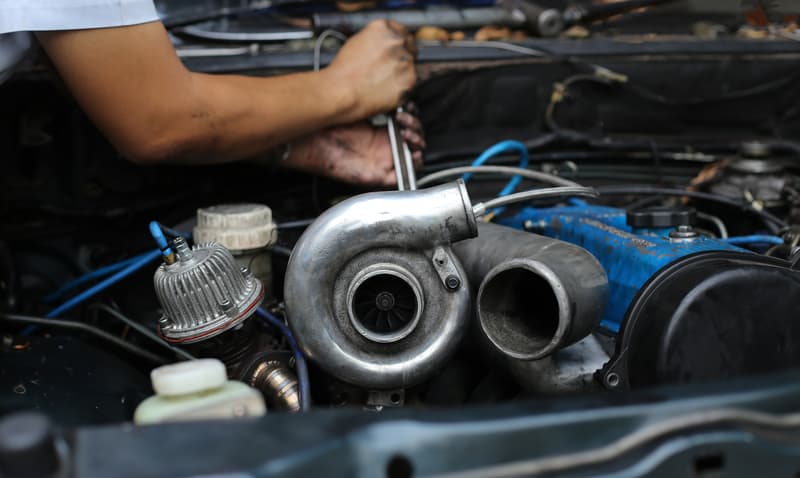
If your Dodge RAM has a Cummins 6.7 liter (1.76 gals) turbo Diesel under the hood, you’ve got yourself a powerful truck.
The Cummins 6.7 is the biggest engine available for the RAM 2500 and 3500. But when a computer check kicks back the P2262 code, what is it—the code—trying to tell you?
A P2262 code means there is a problem with the turbocharger or the supercharger. You may have noticed the issue with a lack of power to the engine or exhaust brake failure. The two most common culprits here are that the units need to be cleaned or have failed completely and need replacement.
Fingers crossed it’s the former because cleaning is certainly easier than replacing. In any case, don’t despair just yet.
This article will take you through some possible causes for the P2262 code and how to fix them.
How Turbochargers Work
Turbochargers are fitted into a vehicle’s airflow system. They tightly compress air—and thus increase the amount—before it flows into the cylinders. More air inside an engine means the engine can burn more fuel, giving the vehicle a significant boost in horsepower.
The vehicle’s airflow spins a turbine in the turbocharger. The turbine spins an air pump—and suddenly, you’ve got more air going into the manifold. Turbochargers can increase an engine’s horsepower by 70 to 150.
However, the P2262 code on a code reader indicates the turbocharger isn’t doing its job. Time to fix that—if you can, hang on for one more short section about superchargers.
How Superchargers Work
A supercharger does the same thing a turbocharger does: It compresses air for the engine manifold, giving the engine more power by burning more fuel.
The main difference is that superchargers get their power from the drivetrain, whereas turbochargers use the vehicle’s exhaust to spin the turbine. One benefit superchargers have:
There is no “lag” as the turbine gets spinning (because the unit is directly powered by the drivetrain).
The 6.7 Liters (1.76 gals) Cummins does not come stock with a supercharger (the system uses variable geometry turbo (more on this below), so we’ll address issues with the turbocharger only.
4 Ways To Fix a P2262 Code on Your 6.7 Liter Cummins
The technical meaning of the P2262 error is “Turbocharger/Supercharger boost pressure not detected.” Regarding the 6.7 liters (1.76 gals) Cummins, we almost always go directly to the turbocharger.
1. Clean the Turbocharger
Over time, soot and carbon can build up inside a turbocharger. This fine debris comes from the truck’s EGR—exhaust gas recirculation.
An EGR valve’s job is to circulate small amounts of the exhaust gas back to the engine’s intake, boosting fuel efficiency and lowering the truck’s emissions (a huge deal for Diesel engines).
Your Cummins engine turbocharger is equipped with turbo vanes that regulate air flow toward the turbine.
The vanes move at different RPMs to give the turbocharger a quicker response time at lower speeds. When soot and carbon build up in the turbochargers, the vanes can no longer move as freely (or not at all).
2. Replace the Turbo Actuator
Dirt isn’t the only thing that can happen to a 6.7 liter (1.76 gals) Cummins turbocharger. The turbocharger’s individual parts can also go bad due to age. Some of these parts are not replaceable beyond swapping out the entire unit. However…
The turbo actuator is replaceable. When it fails, it could kick back the P2262 fault code.
Turbo actuators act as sort of a traffic cop for excessive exhaust gas. It directs the exhaust away from the turbine wheel, maintaining a safe boost pressure for your engine and all of its tiny little parts. Oh, and the turbo actuator also protects the turbocharger from overworking and premature failure.
It’s a bit difficult to describe what a turbo actuator looks like because it’s asymmetrical as a Picasso painting. So I’ll let you look at one in this video:
3. Replace the Turbo Actuator Wire Harness
Also known as an adapter harness, the wire harness attaches a unit to the engine (in this case, the actuator) to give that unit power and allow it to send and receive data from other sources.
It could be this is all that’s causing your trouble. Wire harnesses normally pop right off with a squeeze of the hand.
After you take off the harness, try spraying the connectors with contact cleaner. If the contact cleaner doesn’t work and you still suspect the harness, replace it with a new one.
Remember to reset the check engine light with your scanner or by disconnecting and reconnecting the battery.
4. Replace the Whole Turbocharger
Sorry—we tried all the easy stuff first. If none of the easy stuff worked, then whatever is wrong with the turbocharger is too steep for treatment.
Turbochargers for a 6.7 liter (1.76 gals) Cummins power plant run about $1500. Not cheap, but necessary for the life of your engine.
Because if you ignore a faulty turbocharger…
What Happens if I Ignore a Faulty Turbocharger?

Must we go into the gory details? Very well. Don’t say I didn’t warn you.
Remember that your truck’s engine uses a mixture of fuel and air to produce power. To get more power, you need to burn more fuel; to burn more fuel, you need more air. This last part is where the turbocharger comes in.
A bad turbocharger could cause your engine to overheat. With the turbocharger out of commission, the engine needs to work harder to get your truck going. If this happens, your dashboard temperature gauge will creep up past the normal range.
Turbochargers also use engine oil flow to keep their moving parts lubricated. When the unit fails, an intense mixture of oil, air, and fuel could flow into the engine, causing the engine to rev itself to the max until a catastrophic failure occurs.
On top of these things, tiny little parts of a bad turbocharger can disintegrate and wind up inside your manifold.
Can you drive your Dodge RAM with a bad turbocharger? Yes…for a short period of time. But don’t ignore it. It’s not going to go away like distant relatives come to visit for the holidays—it’s going to stick around, just waiting for a chance to ruin your day (and your truck).
More About Variable Geometry Turbo
Variable geometry turbo is sometimes known as variable vane turbo or variable turbine geometry. This is important because should you decide to research the topic on your own, you’ll come across all three names. It even has a fourth name: variable nozzle turbine.
It all goes back to those movable vanes within the turbocharger. Those vanes are there to regulate the flow of air through the turbine at lower engine speeds, reducing the amount of lag before the turbocharger kicks in.
The 6.7 Cummins uses this technology to make your turbocharger perform a little more like a supercharger (the power comes now rather than later).
VGT dates all the way back to 1953 but did not come into use for production cars until the 1980s. Dodge RAMS equipped with the 6.7 Cummins also uses VGT to control how much exhaust gets recirculated to the engine and to strengthen the exhaust brake.
What Makes a Turbocharger Fail?
The P2262 code has popped up on your reader, and you know that means the turbocharger is faulty. What makes a turbocharger go bad in the first place boils down to a handful of catalysts.
Common reasons for turbocharger failure are:
- Lack of oil
- Contaminated oil
- Debris inside the turbine
- High revving or overclocking of the turbine
Congested or old oil filters can prevent turbochargers from getting enough lubricant—and remember how fast those parts inside of it are moving. Bad oil filters also cause oil contamination, so even if the system is getting enough oil, it may not be sufficient.
To nip this issue in the bud, change your oil filter as recommended by the manufacturer.
Oil leaks also hinder a turbocharger’s ability and will damage it over time. Check the device’s oil feed line periodically and make sure the line is clear. Also, check air intake filters and hoses to make certain they’re not blocked.
Dirty or damaged filters can also send debris into the turbine, hindering its performance—or worse, causing it (the turbine) to seize completely. Keep the air intake clear with a clean filter and ensure other engine parts around the filter aren’t posing a hazard to the intake.
As for unusually high revving of the turbine, this is usually caused by a failed actuator sensor, in which case the sensor needs to be replaced.
Conclusion
You’ve got a powerful Diesel engine under the hood of that truck. Should you notice it losing power, emitting too much smoke, or creating a high-pitched whine, the issue could be with the turbocharger.
A P2262 code confirms it but is by no means a death sentence. Utilizing the above information can get your 6.7 Cummins back to optimal performance.
Other Dodge Cummins error codes and how to fix them:
